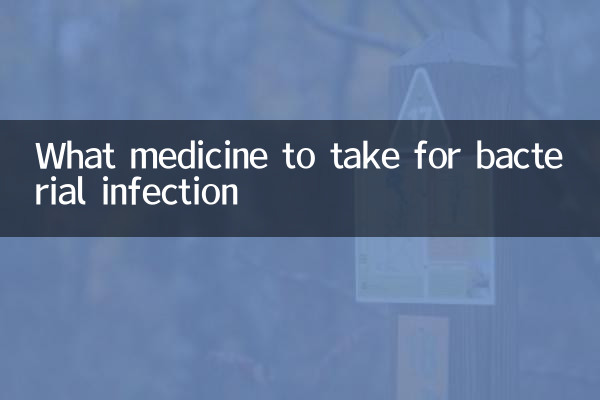What medicine to take for bacterial infection
Bacterial infections are diseases caused by pathogenic bacteria. Common ones include respiratory tract infections, urinary tract infections, skin infections, etc. For different types of bacterial infections, doctors will prescribe corresponding antibiotics based on the pathogen and the patient's condition. The following is a summary and analysis of the popular topics on the Internet in the past 10 days regarding the use of drugs for bacterial infections.
1. Common bacterial infections and corresponding drugs

| Type of infection | Common pathogenic bacteria | Recommended medicine | Medication cycle |
|---|---|---|---|
| respiratory tract infection | Streptococcus pneumoniae, Haemophilus influenzae | Amoxicillin, cefuroxime | 7-10 days |
| urinary tract infection | Escherichia coli, Proteus | Levofloxacin, fosfomycin | 3-7 days |
| skin infection | Staphylococcus aureus | Clindamycin, mupirocin ointment | 7-14 days |
| gastrointestinal infection | Salmonella, Shigella | Norfloxacin, azithromycin | 5-7 days |
2. Precautions when using antibiotics
1.Take medication as directed by your doctor: Antibiotics must be taken strictly according to the dosage and course of treatment prescribed by the doctor. Do not increase, decrease or stop the medication on your own.
2.Avoid drug resistance: Overuse of antibiotics can lead to bacterial resistance, and ordinary infections may evolve into superbug infections.
3.Adverse reaction monitoring: Common side effects include gastrointestinal discomfort, allergic reactions, etc. Severe reactions require immediate medical attention.
4.Medication for special populations: Pregnant women, children, and those with liver and kidney dysfunction need to adjust their medication regimen.
3. Recent hot topics of bacterial infection
| hot events | Bacteria involved | Related drugs | focus of discussion |
|---|---|---|---|
| Diarrhea is more common in summer | salmonella | Ciprofloxacin | Food Safety and Prevention |
| swimming pool conjunctivitis | Pseudomonas aeruginosa | tobramycin eye drops | Public health |
| drug-resistant gonorrhea | Neisseria gonorrhoeae | Ceftriaxone + azithromycin | antibiotic combination |
4. Auxiliary treatment and preventive measures
1.Enhance immunity: A balanced diet and regular sleep can help the body resist bacterial infections.
2.Supplement probiotics: During antibiotic treatment, probiotics can be appropriately supplemented to maintain the balance of intestinal flora.
3.Prevent infection: Frequent hand washing, vaccination (such as pneumonia vaccine), and proper wound treatment can effectively prevent bacterial infections.
4.diet conditioning: During infection, it is advisable to eat a light diet, drink plenty of water, and avoid irritating foods.
5. When Do You Need Medical Treatment?
You should seek medical attention promptly if the following conditions occur: high fever that persists (>3 days), worsening of symptoms, rash or joint swelling and pain, change of consciousness, decreased urine output and other serious symptoms. The elderly, infants and young children, patients with chronic diseases and people with low immunity need to be more vigilant.
Correct use of antibiotics is key to treating bacterial infections. The medication information provided in this article is for reference only. Please consult a professional doctor for specific treatment options. With the recent hot weather in many places, special attention should be paid to food hygiene and wound care to prevent the occurrence of bacterial infections.

check the details

check the details